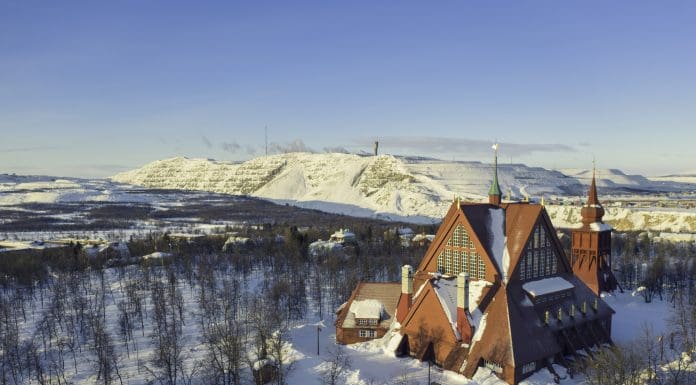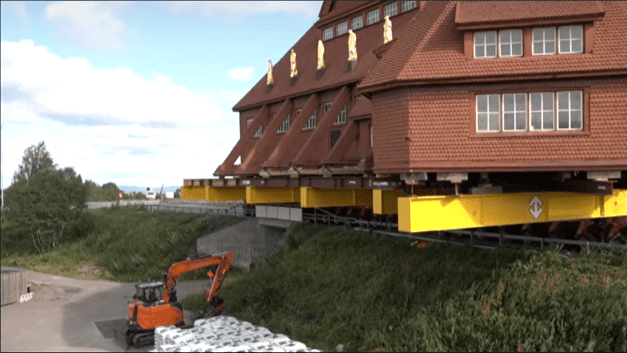
Kiruna Kyrka, a 672-tonne Swedish Lutheran Church first integrated in 1912, is making a 5km journey on rubber wheels over two days, travelling at speeds as high as half a kilometre an hour
The entire Artic town of Kiruna is relocating as a result of ground instabilities caused by a nearby iron ore mine run by the Swedish state-owned mining company LKAB. Kiruna Kyrka, a church described as “the living room of the community”, is the 16th of 23 cultural buildings to relocate.
The relocation is projected to finish in 2035 after eight years of planning and an estimated cost of 500m kronor (£39m).
Ground preparation works for the church’s journey include:
- Preparatory work and widening of roads.
- Demolition of the Lombia Viaduct.
- Work with land and infrastructure.
- Ground preparations in the new location of the church.
- Relocation of Kiruna church and bell tower.
- Moving of Hjalmar Lundbohm’s grave to the church’s new location.
- Restoration of the relocation route after completed relocation.
- Design of new plot and restoration of the old one.
The 40m-tall structure is rolling on remote control flatbed trailers
Road preparations took a year to smoothen the path of the Kiruna Kyrka, as well as widening the roads from nine to 24 metres.
“The church is sitting on a beam system, then two rows of trailers were brought in” and slid underneath the beams, LKAB project manager Stefan Holmblad Johansson said. The entire load will weigh around 1,200 tonnes.
The town has a population of around 18,000, of which 6,000 residents will have to move. LKAB has offered to compensate those who must relocate, either through direct compensation or building a new residence in the new location.
“But when it came to the church, we decided it was best to move it in one piece. We saw the value in that,” Holmblad Johansson continued.
“It is with great reverence we have undertaken this project,” he said. “This is not just any building, it’s a church.”
The belltower, which is next to but separate from the church, will be moved next week.
The church’s design is a homage to indigenous culture
Kiruna Kyrka was designed to resemble a lávvu, a hut of the indigenous Sami people and was designed by Gustaf Wickman, a highly regarded architect who also developed many of Sweden’s banks and hospitals.
The Sami have raised concerns about the expanding presence of LKAB’s mining operations, saying that the ancient rights of the Sami to the land could be compromised, as well as negatively impacting reindeer migration and herding, a key livelihood of many Sami communities.
‘The big church move’ is being televised
Broadcaster SVT is livestreaming the event as “Den stora kyrkflytten” (‘the big church move’), with over 10,000 spectators anticipated at the site to watch the church’s journey.

The church was blessed by Vicar Lena Tjärnberg and bishop Åsa Nyström before the move.
A variety of Swedish celebrities are in attendance, including singer Carola (who will perform at a concert) and the Swedish King, Carl XVI Gustaf. The events will also include an attempt to set a world record for the most church coffee consumed.
The church will open at its new location at the end of the year. You can watch a livestream of the Kiruna Church move here.
The post [VIDEO] Historic Swedish church begins 5km rolling journey appeared first on Planning, Building & Construction Today.

![[VIDEO] Historic Swedish church begins 5km rolling journey](https://afrinfrast.co.ke/wp-content/uploads/2022/03/12175.jpg)